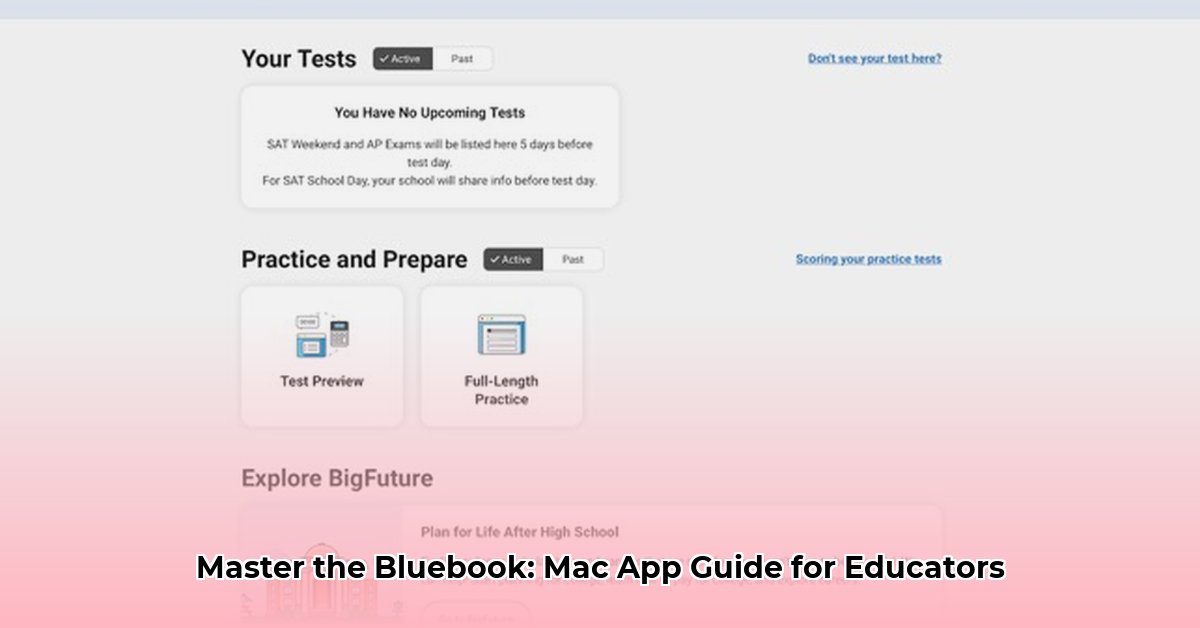
This guide provides a comprehensive walkthrough for downloading, installing, and managing the College Board's Bluebook app on Mac devices for educators and IT staff. We'll cover system requirements, deployment strategies, user account management, troubleshooting, and best practices to ensure a smooth exam administration process.
System Requirements: Ensuring Compatibility
Before downloading, confirm your Mac meets the minimum system requirements. Failure to do so may lead to performance issues or application instability. Check the official College Board website for the most current specifications, but generally, you'll need:
- macOS Version: A specific, recent macOS version is required. (The exact version is available on the College Board website; using an incompatible version may prevent installation.)
- Processor & RAM: Sufficient processing power and Random Access Memory (RAM) are essential for optimal performance. (Insufficient resources may lead to slowdowns and crashes during exams.)
- Storage Space: Adequate free hard drive space is needed for installation and data storage. (Insufficient space will prevent installation. Free up space if necessary.)
- Internet Connection: A stable, high-speed internet connection is crucial for both downloading and updating the application. (Poor internet connectivity might interrupt the exam administration process.)
Downloading and Installing the Bluebook App: A Detailed Walkthrough
These steps guide you through the download and installation process. Remember to always download from the official College Board website to avoid malicious software.
Navigate to the Official Website: Visit the College Board website and locate the Bluebook app download section. (The official site ensures you get the correct and secure version.)
Select the Correct Version: Choose the macOS version compatible with your operating system. Carefully verify compatibility before proceeding. (Incorrect version selection may lead to installation failures.)
Initiate the Download: Click the download button. The installer file (.dmg) will download to your designated download folder. (Monitor the download progress and ensure successful completion.)
Run the Installer: Once downloaded, locate the .dmg file and double-click to open it. Follow the on-screen instructions to complete the installation process. (The installer typically guides you through a straightforward process.)
Verify Installation: After installation, launch the Bluebook app to ensure it functions correctly. A quick test run is recommended to identify any immediate issues. (A test run helps avoid unexpected problems during the actual exam.)
Deployment Strategies: Optimizing for Your Environment
The method you use to deploy Bluebook depends on your school's IT infrastructure and expertise:
1. Individual Student Downloads: This simple method requires minimal IT involvement. Each student downloads and installs the app independently.
- Advantages: Easy to implement, minimal IT overhead.
- Disadvantages: Difficult to manage updates and ensure consistent versions across devices. Security management is more complex.
2. Managed Device Deployment (MDM): This centralized approach allows for streamlined updates, consistent versions, and enhanced security management.
- Advantages: Centralized control, easier updates, improved security.
- Disadvantages: Requires more technical expertise and setup time.
Choose the option that best suits your school's resources and capabilities. For large institutions, MDM is often the superior choice.
User Account Management: Prioritizing Security
Robust user account management is crucial for security and data integrity.
Individual Accounts: Create unique accounts for each student. This allows for individual progress tracking and reinforces security. (Avoid sharing accounts to prevent data breaches.)
Avoid Guest Accounts: Minimize the use of guest accounts for exams, as they offer less security and control. (Guest accounts pose heightened security risks.)
Strong Passwords: Enforce strong, unique passwords for all accounts. (Strong passwords significantly reduce the risk of unauthorized access.)
Regular Account Reviews: Periodically review account settings to identify and address any potential security vulnerabilities. (Proactive review minimizes potential security risks.)
Troubleshooting: Addressing Common Issues
Even with careful planning, problems might arise. Here's how to address common issues:
| Problem | Solution |
|---|---|
| App Crashes | Restart your Mac. Check for software conflicts. Reinstall the app if necessary. Contact College Board support if the problem persists. |
| Connectivity Issues | Verify your internet connection. Check network settings and router. Contact your IT support team if needed. |
| Update Failures | Check your internet connection. Try again later. Consider a manual download and reinstall. If problems persist contact College Board support. |
| Slow Performance | Close unnecessary applications. Ensure sufficient RAM is available. If problems persist, contact College Board support. |
Best Practices: Optimizing Performance and Reliability
These best practices help ensure a smooth exam experience:
- Fully Charged Devices: Ensure all devices are fully charged before the exam.
- Close Unnecessary Apps: Close any applications not needed during the exam to free up system resources.
- Stable Internet Connection: Maintain a consistently strong internet connection throughout the exam.
By following this guide and implementing these best practices, you can ensure efficient and secure Bluebook app deployment and management for your school's exam administration.
⭐⭐⭐⭐☆ (4.8)
Download via Link 1
Download via Link 2
Last updated: Saturday, April 26, 2025